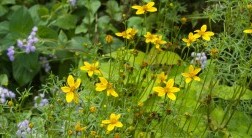Combining shades and tones of the same color or limiting yourself to using a related group of colors is a fun way to create an exciting yet harmonious garden design. A predetermined palette can also make choosing plants easier.

How To Do It
- Create a blazing-hot garden by bringing together fiery reds, blinding yellows, and tropical oranges. To keep this hot theme under control, look for red-flowered cultivars of annuals and perennials that have a hint of yellow or orange in them.
- In a hot-themed design, don't limit yourself to vividly colored flowers; also look for plants with flashy leaves and seedpods like coleus and chiles (Capsicum).
- Three of the most colorful plants can make a hot-palette garden all by themselves: coleus, crotons, and cannas. Add some scarlet sage (Salvia splendens) and a bunch of zinnias from the Sun Series, and you'll have a most unsubtle garden. Introduce some perennials like black-eyed Susans (Rudbeckia), coreopsis, goldenrods (Solidago), an assortment of hot-colored daylilies (Hemerocallis), yarrows (Achillea), and an edging of low-growing marigolds (Tagetes), and the garden will be even more fiery. In the fall the hot theme can be sustained with a collection of bright yellow and bronze chrysanthemums.
- The flip side of the hot monochromatic border is the cool-toned garden. It's just as full of color, but the cooler hues—think pinks, blues, and purples—are more subtle and have a calming effect. Many of the plants that have hot-colored cultivars also come in varieties with cool-colored flowers: zinnias, impatiens, pinks (Dianthus), geraniums (Pelargonium), and the stars of the fall garden, chrysanthemums. Petunias have so many color variations that they alone could make an attractive cool-color garden.

- To warm up a cool-themed garden featuring a lot of blues, mix in some reddish-blue flowers, such as Ceanothus 'Gentian Plume' and Salvia × sylvestris 'Montrose Best'.
- A subtle, elegant silver garden derives much of its magic from foliage colors. Plant choices include lamb's ears (Stachys byzantina), catnips (Nepeta), santolina, and wormwood (Artemisia). Try using an assortment of ornamental grasses, such as 'Heavy Metal' switch grass (Panicum virgatum 'Heavy Metal'), which adds a vertical element to the silver garden, and low-growing bulbous oat grass (Arrhenatherum elatius var. bulbosum 'Variegatum'), which prefers cool shade. Licorice plant (Helichrysum petiolare) is a silver-leafed plant that pulls the garden together as it spreads, covering the spaces between individual specimens.
- A monochromatic garden that takes center stage in low light is a white-flower or moon garden.
- If you want to grow both cool- and hot-colored flowers in a small space, insert some white flowers and silver-leafed plants to create a transition between the two and avoid color clashes.
- A color wheel is a handy little gadget for helping you plan your garden palette. If two colors appear close to each other on the wheel, they will harmonize in the garden. If they are across from each other, they will provide high contrast. Combining too many plants with contrasting flower colors can easily give your garden a hodgepodge look.



